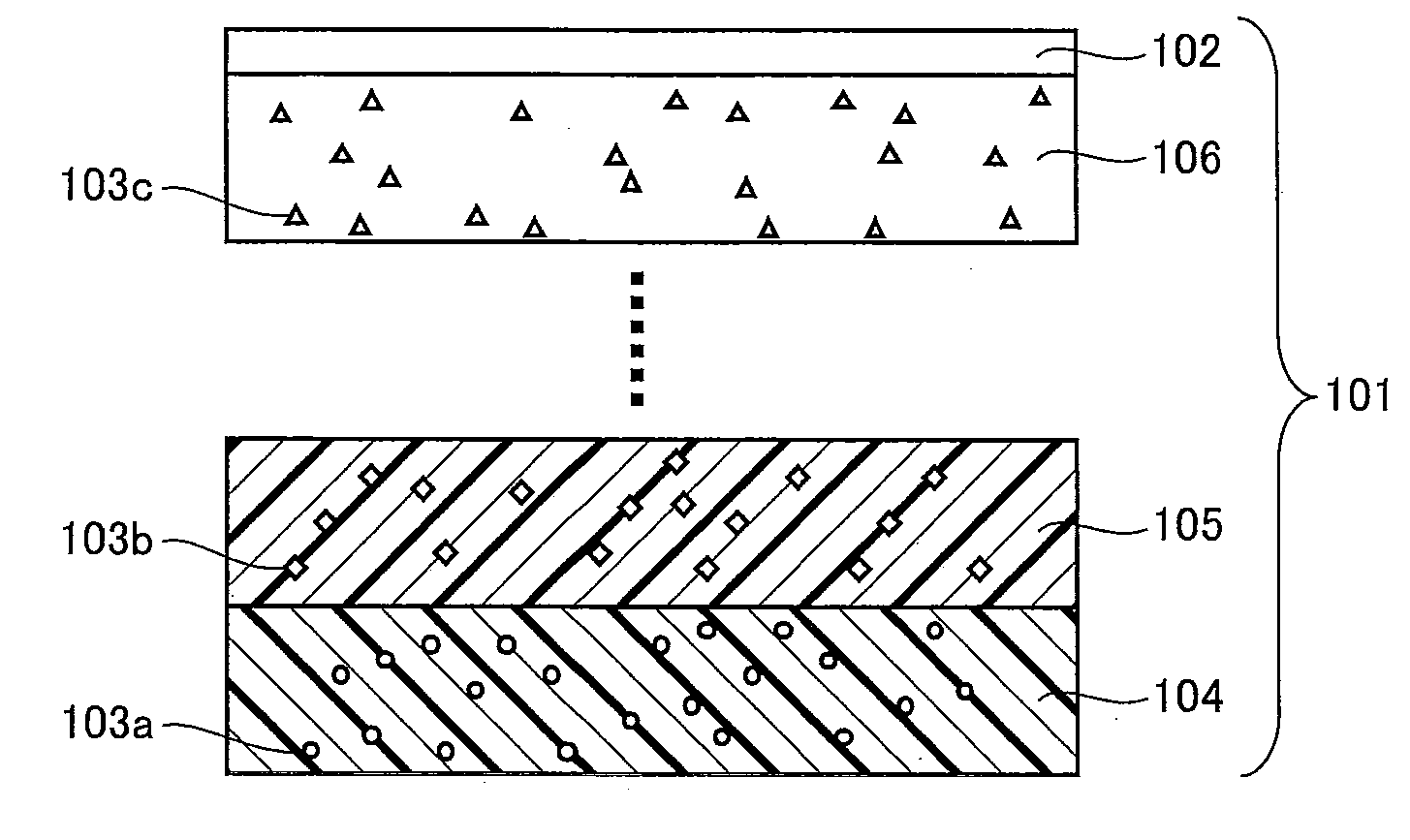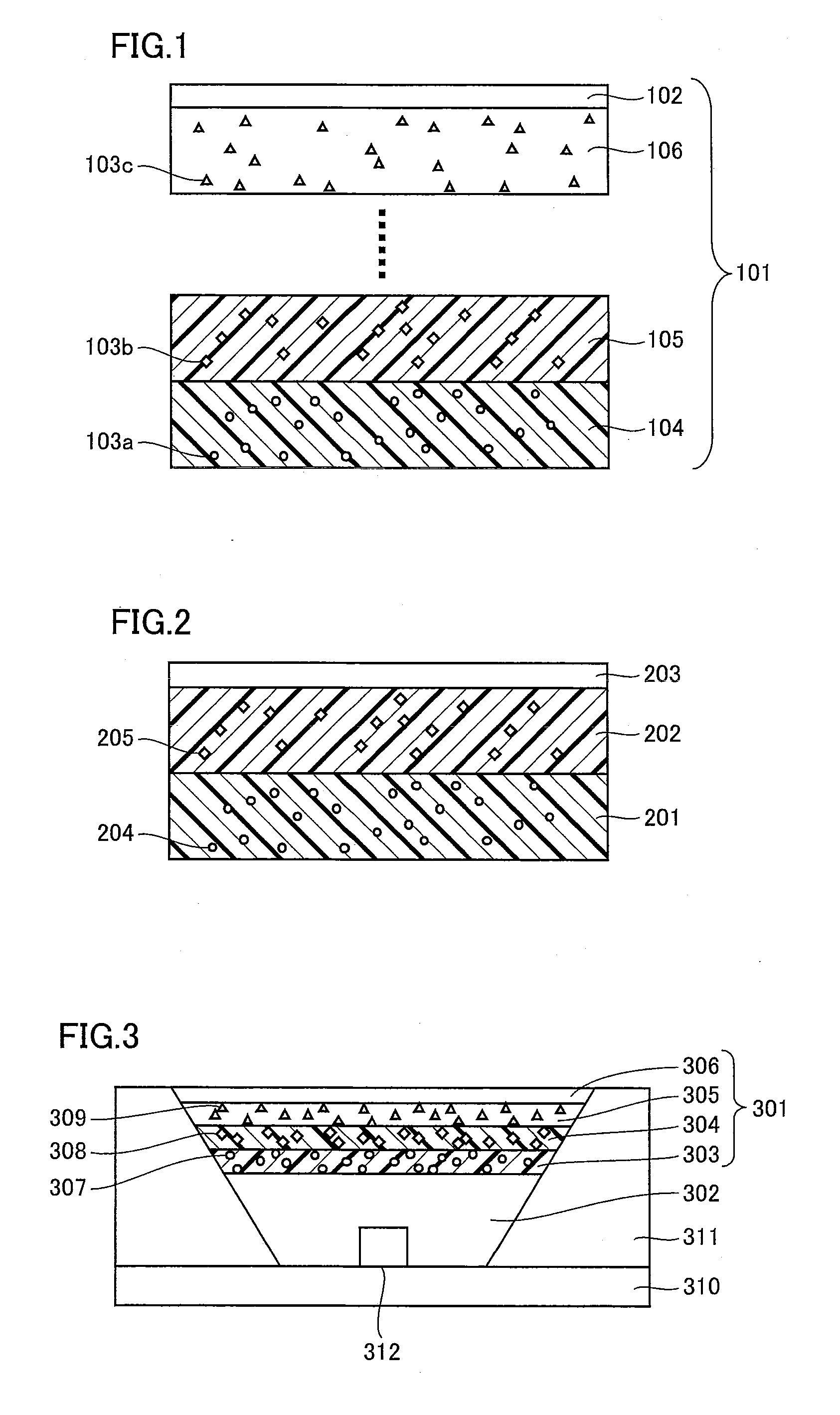Color conversion member and light emitting apparatus using the color conversion member
a technology of color conversion and light emitting apparatus, which is applied in the direction of optical radiation measurement, instruments, spectrometry/spectrophotometry/monochromators, etc., can solve the problems of inability to apply to a practical use, insufficient restrain the degradation of the emission brightness of the light emitting apparatus has a considerably low luminous efficiency, etc., to achieve excellent characteristics, reduce the emission of fluorescence, and improve the external quantum efficiency
- Summary
- Abstract
- Description
- Claims
- Application Information
AI Technical Summary
Benefits of technology
Problems solved by technology
Method used
Image
Examples
example 1
[0085]FIG. 4 shows a schematic cross section of a color conversion member according to Example 1, which will be described hereinafter with reference to FIG. 4.
[0086]The color conversion member of the present example includes a first light transmissive member 401 containing a first phosphor 403 illuminated with an excitation light to emit a red fluorescence, and a second light transmissive member 402 containing a second phosphor 404 illuminated with an excitation light to emit a green fluorescence, and the first and second light transmissive members are stacked in order. A method for manufacturing the color conversion member will be described.
[0087]First, a slurry was prepared by sufficiently mixing a silicone resin (refractive index 1.45) with 1.4% by mass, with respect to the silicone resin, of CaAlSiN3:Eu, namely first phosphor 403 emitting a red fluorescence with a wavelength of 651 nm. The slurry was then poured into a plate-like mold. After poured, the slurry was heated at 150°...
example 2
[0094]Example 2 will be described hereinafter with reference to above-described FIG. 2. In connection with the present example, a description will be given of a color conversion member having a stack structure made up of two different light transmissive members with different refractive indices respectively where one of the light transmissive members having a larger refractive index than the other is covered with another light transmissive member having a smaller refractive index than the aforementioned larger refractive index.
[0095]As first phosphor 204, red emission phosphor CaAlSiN3:Eu with an emission wavelength of 651 nm was used and, as second phosphor 205, green emission phosphor Ca3(Sc, Mg)2Si3O12:Ce with an emission wavelength of 512 nm was used. A silicone resin (refractive index 1.45) was used for first light transmissive member 201, and an epoxy resin (refractive index 1.59) was used for second light transmissive member 202. A similar method to Example 1 was used to prod...
example 3
[0097]FIG. 6 shows a schematic cross section of a color conversion member according to Example 3, which will be described hereinafter with reference to FIG. 6.
[0098]Red emission phosphor CaAlSiN3:Eu with an emission wavelength of 651 nm was used as a first phosphor 605, green emission phosphor SrA2O4:Eu with an emission wavelength of 518 nm was used as a second phosphor 606, and blue emission phosphor BaMgAl10O17:Eu with an emission wavelength of 450 nm was used as a third phosphor 607.
[0099]As a first light transmissive member 601, a second light transmissive member 602, a third light transmissive member 603, and a light transmissive member 604, a silicone resin (refractive index 1.45), an acrylic resin (refractive index 1.49), an epoxy resin (refractive index 1.59), and a silicone resin (refractive index 1.45) were used respectively. A similar method to Example 1 was used to produce a color conversion member.
[0100]The color conversion member thus obtained was excited with light ha...
PUM
 Login to View More
Login to View More Abstract
Description
Claims
Application Information
 Login to View More
Login to View More - R&D
- Intellectual Property
- Life Sciences
- Materials
- Tech Scout
- Unparalleled Data Quality
- Higher Quality Content
- 60% Fewer Hallucinations
Browse by: Latest US Patents, China's latest patents, Technical Efficacy Thesaurus, Application Domain, Technology Topic, Popular Technical Reports.
© 2025 PatSnap. All rights reserved.Legal|Privacy policy|Modern Slavery Act Transparency Statement|Sitemap|About US| Contact US: help@patsnap.com



